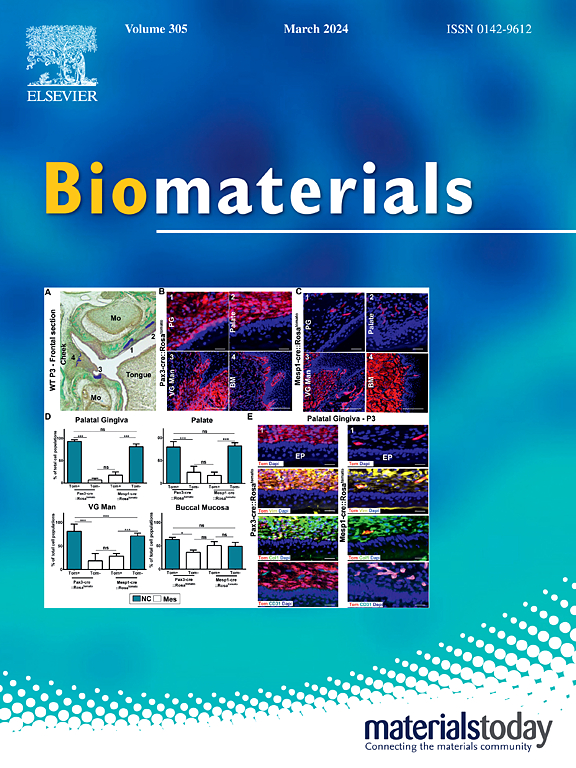可吸入微/纳米颗粒用于大分子治疗药物的肺输送:综述
IF 12.9
1区 医学
Q1 ENGINEERING, BIOMEDICAL
引用次数: 0
摘要
将大分子直接输送到肺部将为目前正在使全世界数百万人衰弱的肺部疾病带来新的治疗方法。这些方法将使新的基因治疗以及其他核酸和蛋白质治疗成为可能,同时以一种非侵入性的方式进行治疗,提高药物疗效,减少全身副作用。尽管将大分子输送到肺部具有令人兴奋的潜力,但在过去的30年里,只有一种治疗方法(即Pulmozyme®)获得了FDA的批准。肺输送的重大挑战阻碍了许多潜在治疗方法的发展。这些挑战包括蛋白质/核酸在包封和递送过程中的稳定性、气道和肺部的清除机制以及递送载体的安全性。研究人员已经开发了多种方法和材料来解决这些问题,包括大分子的改性,用于制造纳米/微粒的新材料(聚合物,脂质和无机物)的开发,以及在配方中添加赋形剂。在这篇综述文章中,我们总结和比较了最近开发的前瞻性肺蛋白/核酸传递载体的合成方法、封装、传递、控释策略和缺点。本文章由计算机程序翻译,如有差异,请以英文原文为准。

Inhalable micro/nanoparticles for pulmonary delivery of macromolecular therapeutics: A review
Direct delivery of macromolecules to the lungs will lead to new treatments for pulmonary diseases that are currently debilitating for millions of people all over the world. These approaches will enable novel gene therapy treatments as well as other nucleic acid and protein therapies, while doing so in a manner that is noninvasive, improves drug efficacy, and reduces systemic side effects. Despite the exciting potential of delivering macromolecules to the lungs, there has been only one therapeutic (i.e., Pulmozyme®) approved by the FDA in the last 30 years. The significant challenges to pulmonary delivery have hindered the development of many potential treatments. These challenges include the stability of proteins/nucleic acids during both encapsulation and delivery, the clearance mechanism of the airway and lungs, and the safety of the delivery vectors. Researchers have developed multiple approaches and materials to address these issues, including modification of the macromolecule, development of novel materials (polymers, lipids, and inorganics) for fabricating nano/microparticles, and the addition of excipients to the formulation. In this review article, we summarize and compare synthesis methods, encapsulation, delivery, controlled release strategies, and the shortcomings of recently developed prospective pulmonary protein/nucleic acid delivery vectors.
求助全文
通过发布文献求助,成功后即可免费获取论文全文。
去求助
来源期刊

Biomaterials
工程技术-材料科学:生物材料
CiteScore
26.00
自引率
2.90%
发文量
565
审稿时长
46 days
期刊介绍:
Biomaterials is an international journal covering the science and clinical application of biomaterials. A biomaterial is now defined as a substance that has been engineered to take a form which, alone or as part of a complex system, is used to direct, by control of interactions with components of living systems, the course of any therapeutic or diagnostic procedure. It is the aim of the journal to provide a peer-reviewed forum for the publication of original papers and authoritative review and opinion papers dealing with the most important issues facing the use of biomaterials in clinical practice. The scope of the journal covers the wide range of physical, biological and chemical sciences that underpin the design of biomaterials and the clinical disciplines in which they are used. These sciences include polymer synthesis and characterization, drug and gene vector design, the biology of the host response, immunology and toxicology and self assembly at the nanoscale. Clinical applications include the therapies of medical technology and regenerative medicine in all clinical disciplines, and diagnostic systems that reply on innovative contrast and sensing agents. The journal is relevant to areas such as cancer diagnosis and therapy, implantable devices, drug delivery systems, gene vectors, bionanotechnology and tissue engineering.
 求助内容:
求助内容: 应助结果提醒方式:
应助结果提醒方式:


